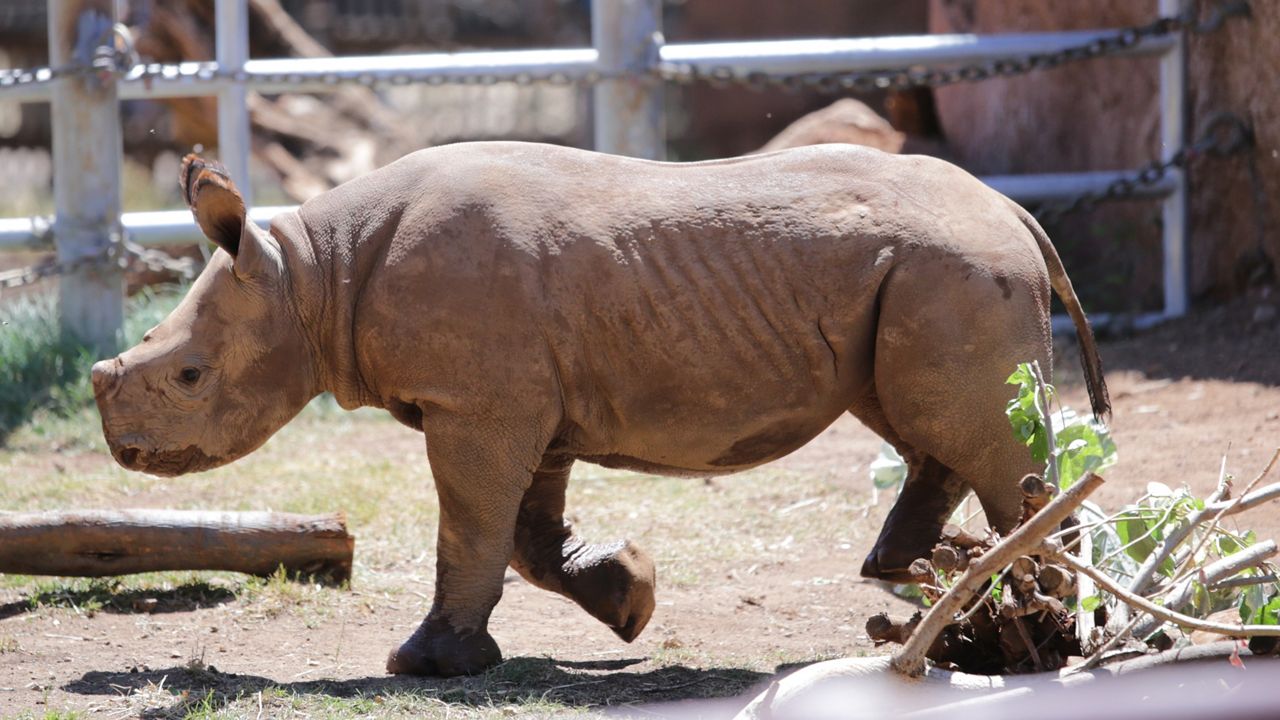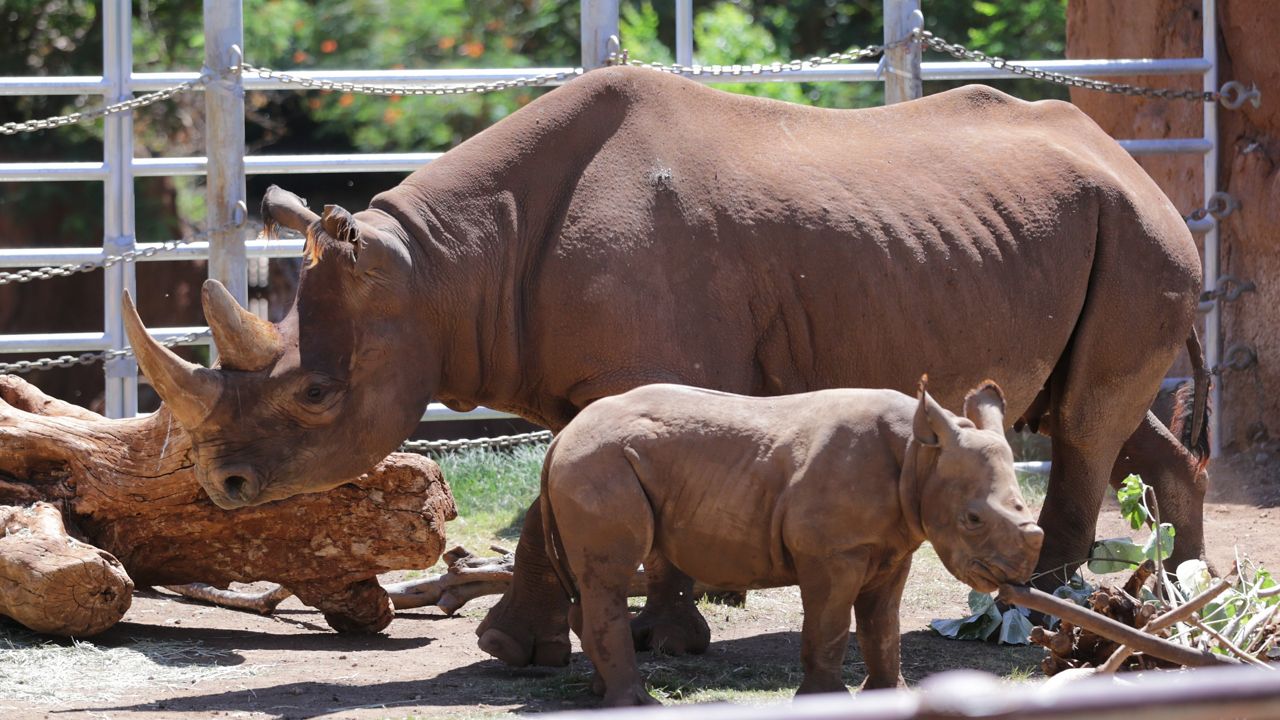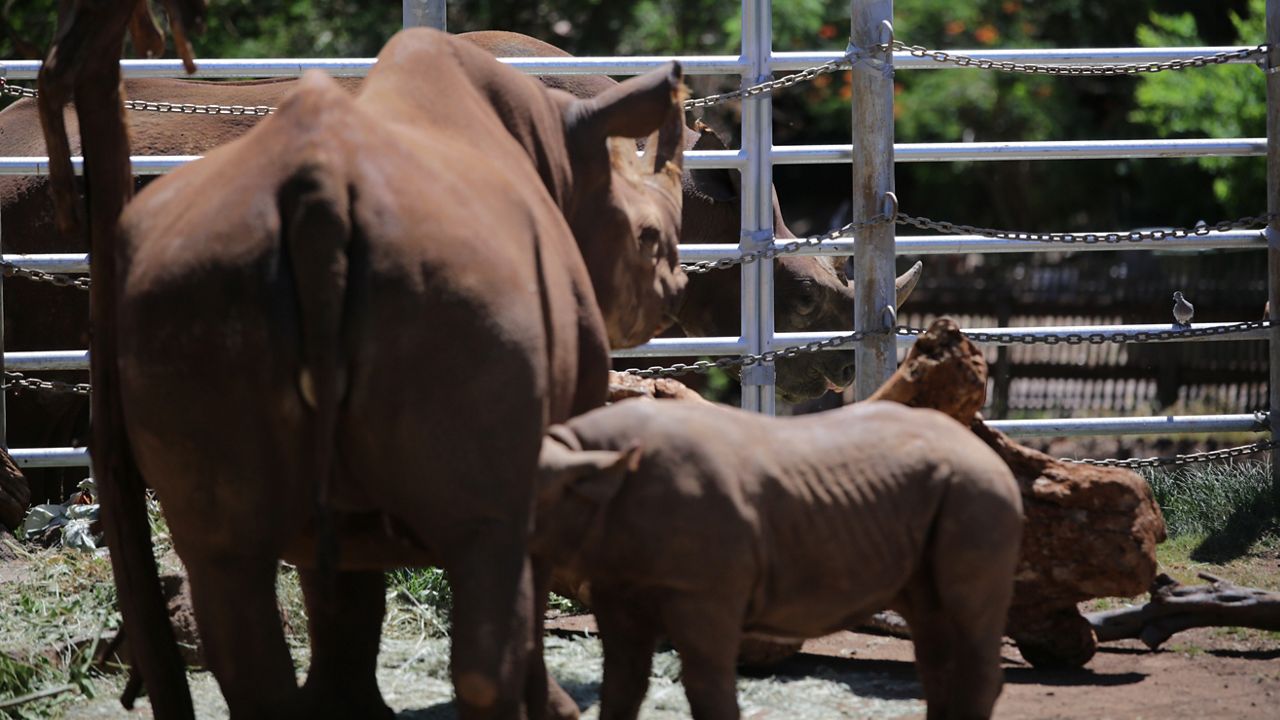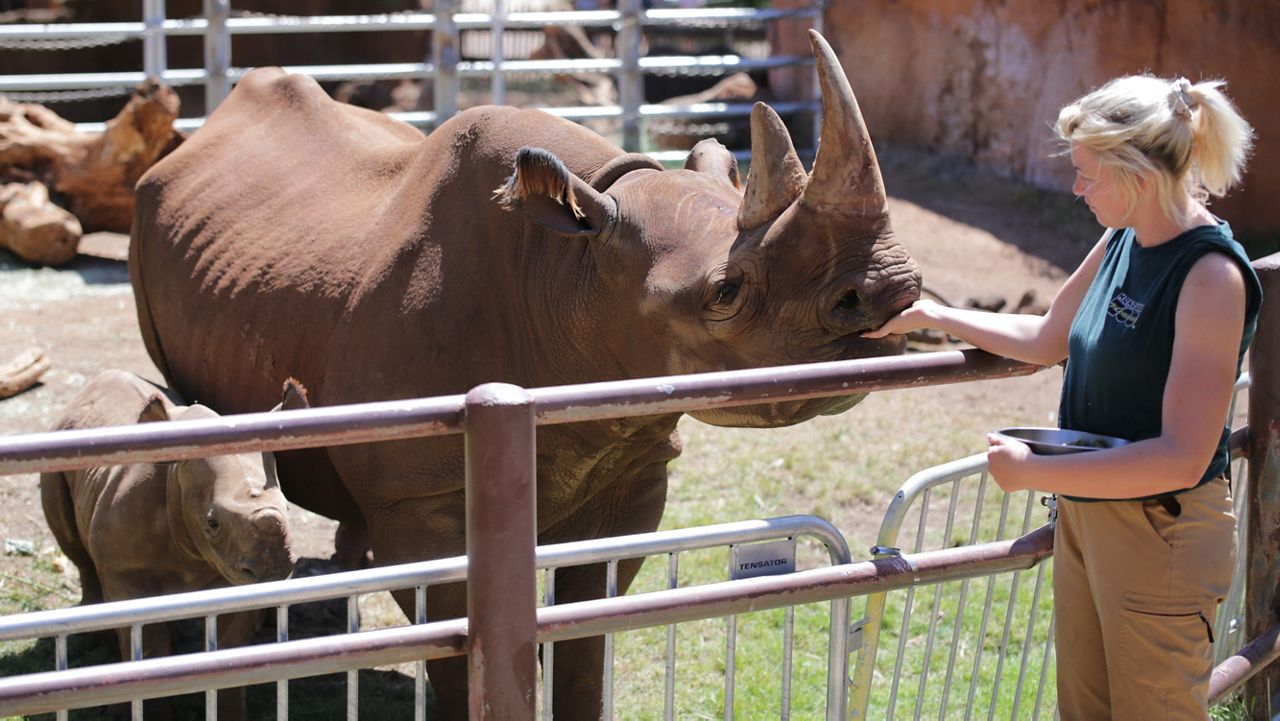HONOLULU — Natalie de Jongh cleans about 300 pounds of rhinoceros poop every day. It’s just a part of her job as a zookeeper at the Honolulu Zoo.
Five-year-old Kendi and nine-year-old Aria are both black rhinos who came to Honolulu from the San Diego Zoo Safari Park last year as a breeding pair. Black rhinos are critically endangered, and breeding them is part of the conservation work every accredited Association of Zoos and Aquariums zoo does. When Aria arrived in Hawaii, she was already in her first trimester. Her baby rhino, Akamu, was born on April 19 at the Honolulu Zoo.
“Akamu was the first baby black rhino to be born at the Honolulu Zoo and also Aria’s first baby. She's … been a super great mom, and we're excited for him to be an ambassador to his species,” said De Jongh.
De Jongh talked with Spectrum News Hawaii on July 14, 2023, while standing next to the black rhino enclosure at the Honolulu Zoo. She was holding pellets of grain and the rhinos — mama Aria and 3-month-old Akamu — eagerly trotted over towards her.
“They know it means they’re going to get some treats,” said De Jongh.
The 26-year-old has worked at the Honolulu Zoo for the past year. Prior to this, she worked at the Alabama Gulf Coast Zoo for two years. She grew up on a farm with goats, chickens, donkeys and horses, and as an undergraduate at Auburn University, she wanted to find a career that she would enjoy, so she majored in Wildlife Ecology and Management.
The rhinos are large. Aria is 2,800 pounds. Kendi is 2,500 pounds. Akamu is 250 pounds.
“Working with ungulates is one of the most physically demanding groups of species to work with. But I think it's really rewarding because they really grow to trust you and you get to build a good relationship with them. They give back a lot of love for the work that you put in for them,” said De Jongh, while looking at the three black rhinos. “But they do poop — I probably scoop like 300 pounds of poop every day.”

De Jongh starts her work day at 7:30 a.m. with a meeting, receiving updates from the veterinarian staff. Next, she says ‘good morning’ to the rhinos and makes sure they are doing well. The rhinos spend most of the night in an indoor enclosure, although they can access their outdoor exhibit if they want. She temporarily restricts rhino access to the outside exhibit so she can clean it. Then the rhinos move into the outdoor exhibit, and she cleans out their sleeping quarters.
According to De Jongh, rhinos kick their poop backwards to mark their territory.
“They grind it into the ground and kick it up onto the walls and everything, so that's super fun to clean up,” said De Jongh.
All the poop she scoops is taken to the zoo’s compost pile and turned into dirt.
“Their pee sticks to everything and is pretty gross, but that’s how they communicate with each other,” said De Jongh, who said a rhino’s urine is another way to mark their territory. “The males also pee backwards (and) their stream can be five or six feet.”
She pointed to a dark spot on the wall in the rhino’s outdoor exhibit where Kendi often peed.
De Jongh spends about an hour every day cutting the rhino’s “browse,” which is zoo-speak for large vegetation. The term comes from the fact that black rhinos are “browsers,” who like to eat leafy plants, twigs, branches, small trees, thorny bushes and grass. (White rhinos are “grazers,” who eat low-growing vegetation.
The zoo grows browse for the rhinos and other animals on site. Right before talking with Spectrum News Hawaii, De Jongh was cutting hibiscus, which she described as a favorite of the rhinos. They also eat monkeypod and kiawe.
“They will eat as much as we can cut,” said De Jongh, who often uses a saw to cut down branches for the black rhinos. “We could cut down like a whole tree and they would eat it.”

For the rhinos, De Jongh also works on different enrichment activities. She brings in perfumes, herbs and spices for them to sniff. They enjoy tactile interaction, so she will brush them with scrub brushes. One of their favorite things is their mud wallow, where they will spend hours playing. On a hot day, De Jongh will set up a sprinkler that the rhinos love running through. Akamu also likes to push his Boomer Ball, a virtually indestructible ball, and logs.
“He's very playful and (he’s) figuring out how to push stuff around with his horn,” said De Jongh.
While we watched the rhinos, Aria nursed Akamu. He will stay with his mother for the first three years of his life. When he is around five years old, he will start a family of his own — most likely at another zoo. And Aria will hopefully continue to have babies.
“In the wild, they would have one (baby) every four to five years,” said De Jongh.
Aria was pregnant for about 15 months. De Jongh said Aria “was getting pretty over it” by the end of her pregnancy and became irritable.
“You could tell she was uncomfortable and just super huge,” said De Jongh. “She was just ready to have that baby.”
While the pregnancy was long, the birth was “so quick,” according to De Jongh.
“She actually had him in a mud wallow. We had a beautiful bed set up for her inside, and she decided to have him in a puddle. I guess she knows better than us. Because she plopped him right out,” said De Jongh.
Akamu was over 100 pounds when he was born. It took him about 30 minutes to stand up and start walking. Within two hours, he had a good latch and was nursing.

Now, Akamu nurses intermittently throughout the day, drinking milk for about five minutes before finding something else to do. Akamu also just started eating solid foods.
“He's getting most of his nutrition from (his) mom still … and he'll continue to nurse for the next two or so years,” said De Jongh.
One of Akamu’s favorite snacks is his mom's poop — it helps him develop his microbiome.
“Every morning, we come in and he walks up, and he's just got poop on his face. I'm like ‘you're so cute, but I'm not gonna pet you right now,’” said De Jongh.
Currently, the zoo houses Kendi in an adjacent but separate area from Aria and Akamu. In the wild, mother rhinos and their babies would go off on their own.
“Kendi is … super sweet. We’re not really worried about him as much as we’re worried about Aria bullying him a little bit. She likes to put him in his place and she's not always tolerant of him being in her space,” said De Jongh.
When Akamu is bigger, the zoo hopes to introduce them all and “have them be one happy family,” said De Jongh. “So far, they've been doing really well with their interactions through the barrier.”
De Jongh and her colleagues all have a relationship with the rhinos. It’s important for Aria to trust the zoo keepers, so that she will allow them to interact with Akamu.
“She’ll go off and take a nap while we’re playing with the baby,” said De Jongh.
She said trust also helps with veterinary care and grooming.
“We train them to let us pick up their feet for hoof care. They have a block they can put their foot on so we can trim their nails,” said De Jongh.
Rhinos are a “protected contact species,” meaning there is always a barrier between them and zoo keepers, so De Jongh reaches over the barrier to pet the rhinos. The barrier is mostly to keep zoo keepers safe from being accidentally hurt, as rhinos are normally friendly, according to De Jongh. Like a horse, they can get spooked and they also have poor eyesight. The rhinos can approach the barrier if they want to be scratched, and can walk away if they don’t want to interact.
“With the baby, when we rub him, he’ll lay down and rollover, so you can touch him,” said De Jongh.
Michelle Broder Van Dyke covers the Hawaiian Islands for Spectrum News Hawaii. Email her at michelle.brodervandyke@charter.com.




